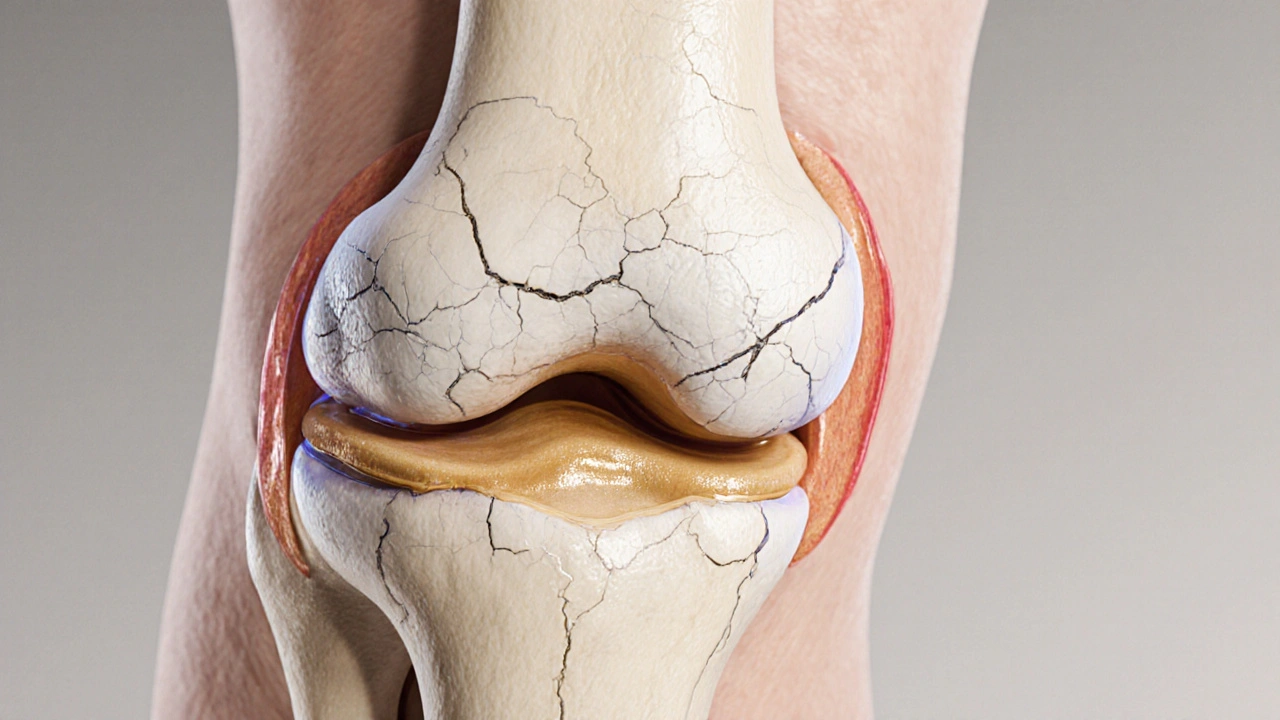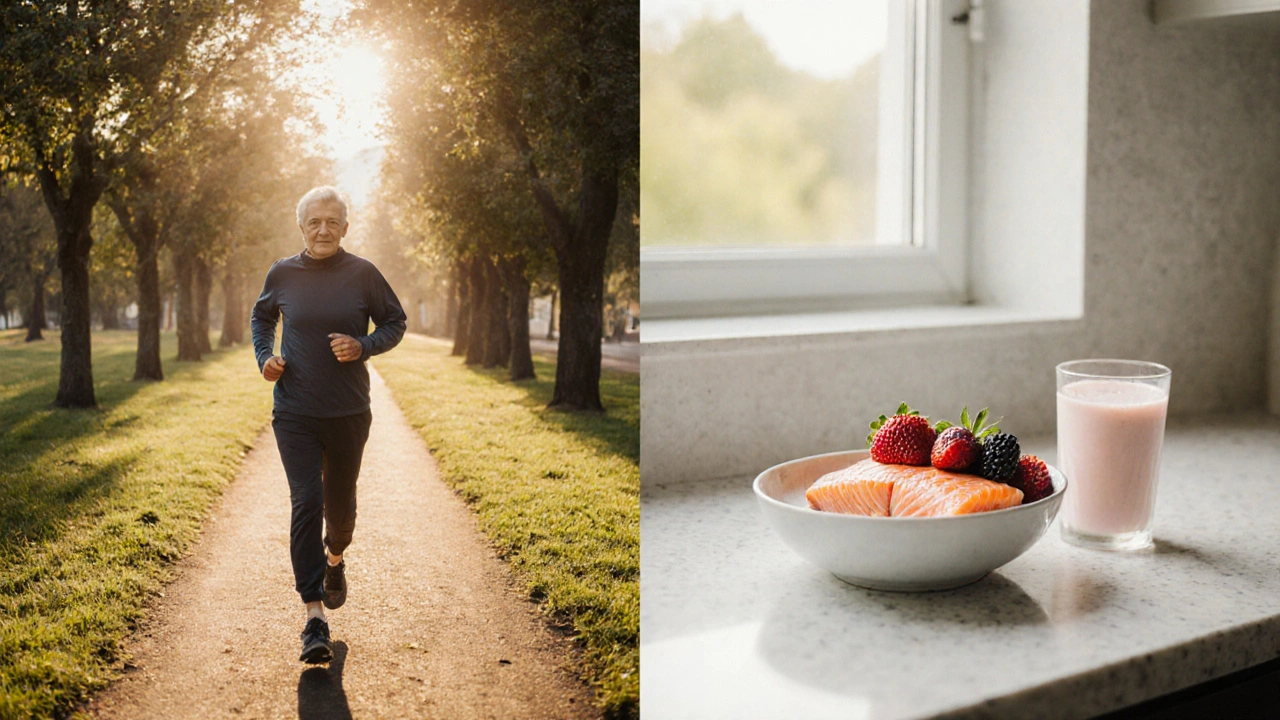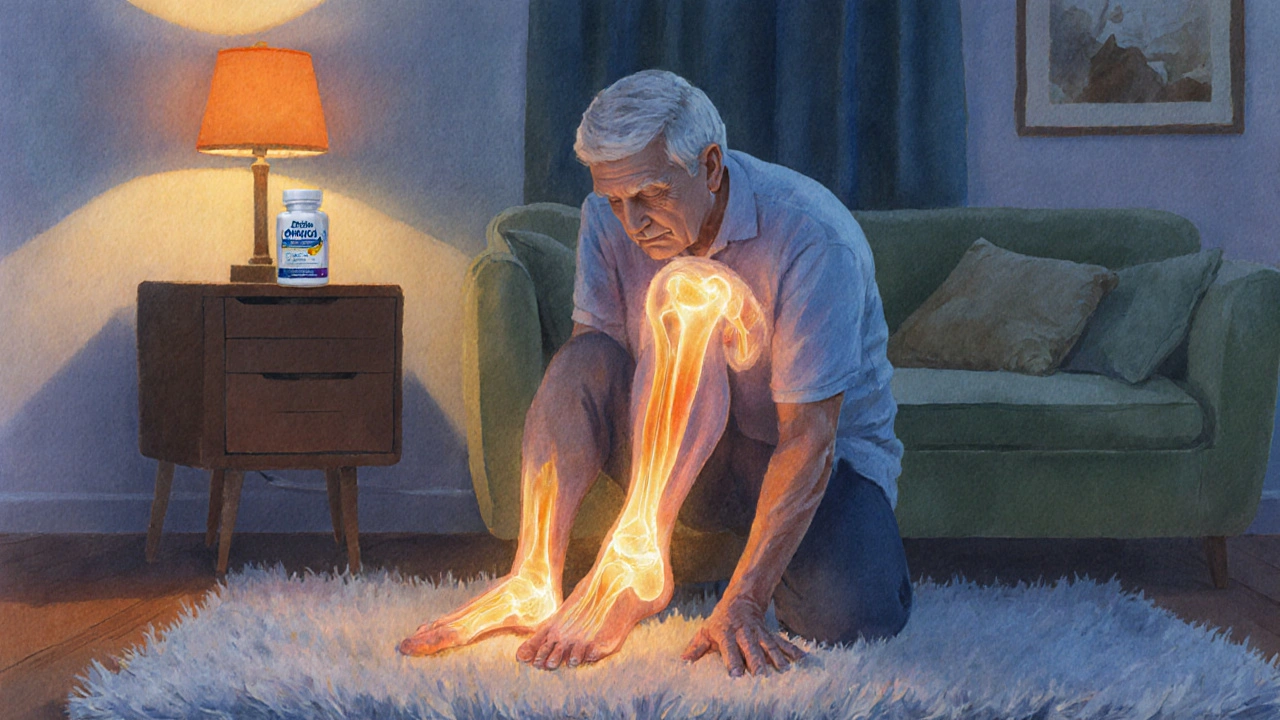Joint Damage & Aging: What Happens and How to Protect Your Joints

Joint Health Risk Assessment
Answer the following questions to assess your joint health risk:
This assessment helps identify potential joint issues and suggests preventive steps.
Your Joint Health Risk Assessment
Key Takeaways
- Joint structures naturally lose cartilage and fluid as you age, making stiffness and pain more likely.
- Regular low‑impact exercise, balanced nutrition, and healthy weight are the most effective defenses.
- Supplements such as glucosamine, omega‑3s, and vitamin D can support joint function, but they work best alongside lifestyle changes.
- Early signs-like occasional creaking or mild swelling-should prompt a simple self‑check rather than waiting for severe discomfort.
- Consulting a rheumatologist or physiotherapist early can slow degeneration and keep you moving.
When it comes to staying active as you age, joint health becomes a major focus. Understanding what happens inside your joints over time and learning practical ways to protect them can mean the difference between a life of mobility and one limited by pain.
What Happens Inside a Joint as You Age
Joint is the point where two bones meet, surrounded by cartilage, synovial fluid, and a capsule that enable smooth movement. As you get older, three key components start to change:
- Cartilage is a smooth, rubbery tissue that cushions bone ends. Its ability to repair slows, leading to thin spots and micro‑cracks.
- Synovial fluid is the lubricating liquid that reduces friction. Production drops, so the joint feels less slippery.
- Low‑grade inflammation a chronic, mild immune response builds up, subtly eroding tissues.
These shifts don’t happen overnight. Most people notice a gradual stiffening in the morning, a faint grinding sound when standing up, or a slight loss of flexibility after a long day.

Common Types of Age‑Related Joint Damage
While everyone experiences some wear, two conditions dominate the conversation:
- Osteoarthritis is a degenerative disease where cartilage thins and bone spurs form. It typically starts in weight‑bearing joints like knees, hips, and the spine.
- Rheumatoid arthritis is an autoimmune condition that attacks joint linings, causing swelling and deformity. Though not purely age‑related, its risk rises after 60.
Other issues-such as bursitis, tendinitis, or meniscal tears-often coexist, especially in people who stay active without proper warm‑ups.
Everyday Lifestyle Strategies to Protect Your Joints
The most reliable defense isn’t a fancy gadget; it’s a consistent routine that targets the three aging components mentioned earlier.
1. Move Smart - Low‑Impact Exercise
Regular movement keeps synovial fluid flowing and trains muscles to support joints. Aim for at least 150 minutes of low‑impact cardio per week, such as:
- Brisk walking or Nordic walking (helps maintain bone density and improves circulation).
- Swimming or water aerobics (provides resistance without joint compression).
- Cycling on a stationary bike (strengthens quadriceps, which protect the knee).
Incorporate strength training twice weekly. Focus on exercises that reinforce the muscles around your most vulnerable joints:
- Squats or chair‑stand variations for the knees and hips.
- Wall push‑ups and resistance‑band rows for the shoulders and elbows.
- Core stability drills (plank variations) to reduce strain on the spine.
Finish each session with gentle stretching. Holding each stretch for 20-30 seconds improves cartilage nutrition by enhancing blood flow.
2. Eat for Joint Resilience
Nutrition supplies the building blocks cartilage needs to repair itself. Key food groups include:
- Omega‑3 fatty acids - found in salmon, sardines, and flaxseed; they curb inflammation.
- Collagen‑rich sources - bone broth, chicken skin, and gelatin support cartilage matrix.
- Antioxidant vegetables - leafy greens, berries, and bell peppers neutralize free radicals that accelerate tissue breakdown.
- Vitamin D and calcium - dairy, fortified plant milks, and sunlight exposure keep bones strong, reducing joint stress.
Maintain a modest caloric intake to keep body weight in a healthy range. Every extra pound forces knees to absorb roughly four additional pounds per step.
3. Manage Weight and Posture
Even a 5‑% reduction in body weight can lower knee‑joint load by up to 20%. Simple habits-like using a standing desk, keeping phone screens at eye level, and sleeping on a supportive mattress-prevent compensatory strains that could damage joints over time.
Targeted Supplements and Medical Interventions
Supplements aren’t a magic bullet, but several have strong evidence for supporting joint structures.
| Strategy | Primary Benefit | Key Example | Recommended Frequency |
|---|---|---|---|
| Low‑Impact Exercise | Maintains synovial fluid flow & muscle support | 30‑minute brisk walk | 5×week |
| Omega‑3 Rich Nutrition | Reduces chronic inflammation | Two salmon servings | 3×week |
| Glucosamine & Chondroitin | May slow cartilage breakdown | 1500mg glucosamine + 1200mg chondroitin | Daily |
| Weight‑Management Coaching | Lowers joint load and pain | Certified dietitian plan | Ongoing |
Glucosamine and chondroitin are the most studied supplements for osteoarthritis. A 2023 meta‑analysis showed a modest 10‑15% pain reduction in people who took the combo for at least six months.
Vitamin D deficiency is linked to faster cartilage loss. Testing your serum level once a year and supplementing to reach 30‑50ng/mL can be protective.
If pain persists despite lifestyle tweaks, a rheumatologist may prescribe topical NSAIDs, intra‑articular hyaluronic‑acid injections, or-when disease progresses-minimally invasive joint replacement.

Practical Daily Checklist to Keep Joints Happy
- Morning: 5‑minute gentle shoulder roll, ankle circles, and light knee flexion.
- Mid‑day: Take a 10‑minute walk or perform a set of standing leg extensions.
- Lunch: Include a serving of oily fish or add ground flaxseed to your salad.
- Afternoon: Stretch calves, hamstrings, and forearms; use a resistance band for 2‑3 sets of rows.
- Evening: Check your posture while watching TV; use a lumbar pillow if needed.
- Before bed: Apply a warm compress to any sore joint for 10minutes, then do a short breathing exercise to reduce inflammation.
This routine takes less than 30minutes total and can be adjusted based on personal schedule and joint‑specific needs.
Frequently Asked Questions
How can I tell if my joint pain is normal aging versus a condition like osteoarthritis?
Normal aging usually brings occasional stiffness that eases after a few minutes of movement. Persistent pain, swelling, or a grinding sensation that limits daily activities often signals osteoarthritis and should be evaluated by a health professional.
Is it ever too late to start exercising for joint protection?
Never. Even people in their 80s who begin low‑impact activity report reduced pain and better mobility. Start slowly, focus on range‑of‑motion movements, and let a physiotherapist guide you.
Do supplements really work, or are they just a placebo?
Clinical research shows mixed results. Glucosamine‑chondroitin combos have modest benefits for some individuals, especially when cartilage loss is mild. Omega‑3s consistently reduce inflammatory markers, which can translate to less joint discomfort.
How much weight loss is needed to relieve knee pressure?
Losing 5-10% of body weight can cut knee‑joint load by 20-40%. For a 200‑lb individual, that’s a 10‑20lb reduction and often enough to notice less pain during stairs or prolonged standing.
When should I consider seeing a rheumatologist?
If joint pain lasts more than a few weeks, worsens at night, or is accompanied by swelling, stiffness lasting over an hour, or reduced range of motion, schedule an appointment. Early diagnosis can keep degeneration slower and treatment options broader.
Next Steps for Different Scenarios
Scenario A - You’re already active but notice occasional knee creak. Add a 10‑minute post‑workout stretching routine focusing on quads and calves, and schedule a quick check‑in with a physiotherapist for a form audit.
Scenario B - You’ve become more sedentary after retirement. Start with a daily 15‑minute walk, then gradually introduce water aerobics twice a week. Pair each session with a protein‑rich snack to aid muscle recovery.
Scenario C - You’ve been diagnosed with early‑stage osteoarthritis. Combine low‑impact cardio with a glucosamine‑chondroitin supplement, aim for a BMI under 25, and discuss hyaluronic‑acid injections with your rheumatologist if pain spikes after activity.
Whatever your starting point, consistency beats intensity. Small daily actions add up to stronger joints and a more vibrant life.
Keep moving, your joints will thank you! 😊
In many cultures, daily walking is the secret to joint longevity.
The pathophysiology of articular degeneration is inexorably linked to systemic inflammatory cascades, which, if left unchecked, precipitate chondromalacia and osteophyte formation. One must recognize the moral imperative to adopt a diet replete with omega‑3 fatty acids, polyphenols, and antioxidants, as these bioactive compounds exert modulatory effects on NF‑κB signaling and cytokine production. Moreover, the biomechanical stress‑strain relationship dictates that repetitive micro‑trauma without adequate recovery engenders subchondral bone sclerosis. By embracing a regimen of low‑impact aerobic activity-such as aquatic therapy or Nordic walking-individuals can enhance synovial fluid viscoelasticity while preserving cartilage integrity. It is ethically reprehensible to ignore the evidence‑based guidelines promulgated by orthopedic societies, which advocate for weight management as a cornerstone of joint preservation. Excess adiposity amplifies leptin‑mediated catabolic pathways, exacerbating proteoglycan degradation. The salient point is that sedentary lifestyles foster insulin resistance, which indirectly compromises musculoskeletal health via advanced glycation end‑product accumulation. Therefore, the judicious integration of resistance training, with an emphasis on eccentric loading, fortifies periarticular musculature and attenuates joint loading forces. Clinical trials have consistently demonstrated that vitamin D sufficiency modulates mineralization homeostasis, further supporting joint resilience. Neglecting these preventative strategies not only jeopardizes individual well‑being but also imposes a societal burden through increased healthcare expenditures. In sum, the confluence of nutritional adequacy, calibrated physical activity, and vigilant weight control constitutes a triad of prophylaxis against joint degeneration. Let us, as custodians of our own bodies, enact these measures with resolve and integrity.
Honestly, most of these "tips" are just common sense wrapped in jargon. If you don't move, your joints will stiffen-no surprise there. The article glosses over the fact that genetics play a huge role, and you can't just blame lifestyle alone. Also, the emphasis on "anti‑inflammatory foods" feels like a marketing ploy; you can get the same benefits from a balanced diet without obsessing over berries. In short, it's neat advice, but it's not revolutionary.